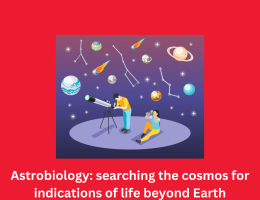
Exoplanets: Worlds Beyond Our Solar System
- By admin --
- Friday, 08 Mar, 2024
Our information of the universe has been completely converted by using the invention of exoplanets, or planets circling stars outside of our sun device. It has also raised critical issues over the opportunity of extraterrestrial existence. Astronomers have used a variety of detection strategies to locate loads of these alien worlds because the first established exoplanet discovery in 1992. We shall examine diversity of planets; ways they are formed; tactics for knowing them; if there might be life or not and interesting chances they give for finding other living creatures while conducting our research.
Diversity of Exoplanets:
Exoplanet sizes, compositions, and orbital configurations range substantially. Based on their homes, they will be divided into a number of companies, including Earth-like terrestrial planets, gas giants like Jupiter and Saturn, and ice giants like Uranus and Neptune. Exoplanets also show a variety of orbits: from some distance-off, bloodless worlds living in the farthest areas of their planetary systems to near-in hot Jupiters orbiting near their parent sun.
Formation Mechanisms:
Within protoplanetary disks, which are whirling clouds of gasoline and dust that encircle newborn stars, exoplanets originate. These disks give delivery to planetary embryos at some stage in gravitational fall apart, which in the end turn into fully formed planets by means of accreting matter. The specific tactics that manage the introduction and improvement of exoplanetary systems depend on variables just like the determine famous person's characteristics and the protoplanetary disk's mass and make-up.
Detection Methods:
Exoplanets are hard to find because of their vulnerable mild and near closeness to blazing stars. In order to recover from these demanding situations and locate those a ways-off planets, astronomers have devised some of awesome strategies. The transit technique is a famous method that measures the superstar's mild's small dimming while an exoplanet passes in front of it, obstructing some of the star's brightness. An opportunity technique for locating exoplanets is the radial velocity approach, which measures the tiny wobbles in a celeb's motion caused by planets circling it. Astrometry, gravitational microlensing, and direct imaging are greater strategies that offer wonderful insights into the characteristics of exoplanetary structures.
Habitability and Potential for Life:
Is life viable on those some distance-off worlds? This is one of the most intriguing subjects in exoplanet look at. The situations required to help life as we comprehend it, consisting of the supply of liquid water, a strong environment, and suitable temperatures, are called habitability. In the habitable sector, that's the location round parent stars wherein liquid water can also exist on a planet's surface, scientists look for exoplanets.
Determining if existence exists past Earth remains a tough mission, no matter the general public's fascination in the discovery of probable habitable exoplanets. Future tasks just like the James Webb Space Telescope and the following technology of area-based totally observatories are seeking for to discover feasible biosignatures and examine exoplanet atmospheres.
Tantalizing Prospects:
Unprecedented possibilities to analyze the form of planetary structures and provide perception into the mechanisms guiding planet formation and improvement are offered through the examine of exoplanets. Furthermore, there is improved discussion concerning the chance of discovering lifestyles outdoor of our solar system and the presence of alien lifestyles because of the discovery of Earth-like exoplanets inside the habitable zones in their figure stars.
Conclusion:
One of current astronomy's maximum fascinating areas is the look for exoplanets. These some distance-off planets might provide crucial facts about the range and abundance of life in the universe, as well as provide the important thing to comprehending our role in it. Future generations of scientists and explorers are sure to be enthralled and prompted via the quest for exoplanets and evidence of life beyond Earth, as generation develops and our capacity for commentary grows.





